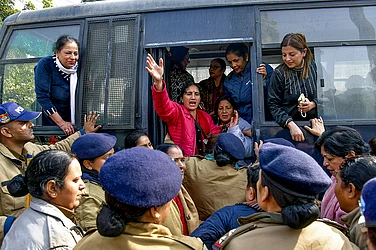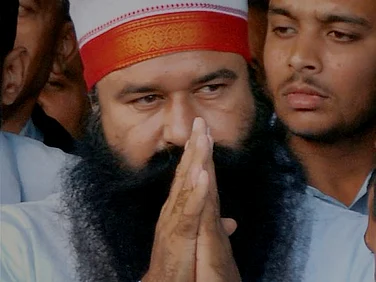
And if one goes by the latest seismic zoning map of India, brought out by theIMD and the Geological Survey of India, there will be no place to hide if a high-magnitude earthquake occurs. Four types of zones have been demarcated on the map—a very high risk zone, high risk zone, moderate risk zone and low risk zone. Much of India—57 per cent of the land surface—lies in the high risk zone (see map); 12 per cent falls in the very high risk zone category. Till a few years ago, there was a Zone One, which represented areas where chances of a quake were remote. That categorisation has since been removed. The conclusion: with the possible exception of parts of Rajasthan and a bit of Karnataka, no place is quake-proof.
The December ’05 Koyna prediction is based on the study of water levels in both the dam and the nearby Warna reservoir, which have reached peak levels. One indicator of the imminence of a quake is increased water levels due to seismic activity below the surface of the earth. Points out Dimri: "Since 1967, there have been 19 quakes of magnitude 5 in the region. This year, the patterns that precede such quakes are similar to the ones that have occurred in the past. Following rains, seismic activity has increased. But there is no cause for panic as the dam can withstand the intensity." Dimri and other seismologists believe real-time predictions, four hours before the actual occurrence of a quake, are also possible in such locally defined contexts.
What is left unsaid is that an earthquake of even a point more than 5 on the Richter could impact neighbouring areas. Seismologists say when the magnitude rises by one point on the Richter scale, the energy released along the crust gets multiplied 30 times. Step back to December 10, 1967, when a 6.2 quake struck southwest of Bhambiya (Maharashtra), believed to be the strongest reservoir-induced earthquake in the world to date. It not only left 80 per cent of the buildings at Koynagar damaged, but also shook windows and doors in Mumbai 194 km away from the epicentre.
The ominous conclusions on India’s vulnerability comes from the seismic mappers themselves. A good number of precursors/indicators are studied after an earthquake has actually occurred. A change in water levels on the surface and under the ground, release of gases (particularly radon) prior to the actual quake and its presence in the underground water are pointers. Mappers also correlate activity in the earth’s ionosphere with what is happening in the belly of the earth. Liquefaction (some soils behave like liquids after a quake) is also studied. "A 100 per cent prediction is the preserve of astrologers, not scientists. The presence of faults (indicators of cracks in the surface of the earth that trigger quakes) is not enough for predicting an earthquake with absolute accuracy even in the short term (3-6 months)," says Bhatnagar.

Agrees geologist V.C. Thakur of the Wadia Institute of Himalayan Geology, Dehradun, "As earthquakes repeat in time and space, our efforts are also directed to finding recurrence intervals of the event through palaeo-seismological studies." Scientists have categorised four types of tectonic zones in their attempts to study the nature of quakes—the Himalaya-Nagaland-Manipur-Andaman Alpine belt; Kutch in Gujarat; Assam-Tripura-Shillong zone and Stable Peninsular India. What seismologists take recourse to are faults that appear on the earth’s crust, where epicentres emerge, leaving room for future predictions.
"The earthquake on October 8 took place as a result of the Indian plate moving under the Eurasian plate and rotating slowly anti-clockwise. India, one should remember, is moving at a rate of 40 mm every year and pushing against Tibet," says Thakur. The Himalayan region falls along the boundaries of these plates and experts fear a greater quake (magnitude of 8-plus) is overdue in North India.
Seismologists say the central Himalayan region has had only 15-16 quakes with a magnitude of over 7 in the last 100 years. "The Indo-Gangetic plain is particularly susceptible when quakes of high magnitude occur in the Himalayas," says Bal Krishna Rastogi, emeritus at ngri, Hyderabad. Agrees Thakur, "The segment of the Himalayan region including Kashmir has a past ‘history’ in earthquakes: 25 AD—Taxila, 1550—Kashmir Valley, 1878—Abbottabad and 1885 in Kashmir again."
Prof A.S. Arya, who advises the home ministry on disaster management, headed the committee that brought out the Vulnerability Atlas detailing districts in India susceptible to earthquakes, cyclones, floods and landslides. According to him, there are seismic belts in the world and one called the Himalayan Alpine Belt (running through Turkey, north of Iran, Pakistan, Himalayas, Burma into the Andaman Nicobar Islands) is a huge tectonic belt of high activity.
So with the fair amount of information at our disposal, what is the state of our preparedness? "Post-tsunami, we’ve started a seven-day training programme for planners and a 15-day extensive programme for engineers with the government. We intend to involve other players too. Ideally, there should be a proposal put in place asking builders to submit their designs to a select committee of experts," says Arya.
The Vulnerability Atlas of the country, first prepared in 1998 and revised since then, has mapped districts in India which are vulnerable to quakes, cyclones, floods and landslides. With the exception of Rajasthan, virtually all states face some risk or the other from some disaster waiting to happen. Some like Andhra Pradesh are vulnerable to not only quakes but cyclones and floods, often following in succession.
India has a ‘shaky’ past. If one delves into history, there have been many quakes—not all of them have been recorded—which presents a problem in working out a model for estimating recurrence of such events. Early references are there in the extracts of the Mahabharata (during the Kurukshetra battle); a probable earthquake in 538 BC; another near the ancient city of Dwaraka along the seismically sensitive coastal zone of Gujarat, hazily dated around the onset of the Common Era. From then on, there are references to a massive quake in the Kathmandu Valley in 1255 AD; and a tsunami in 1524.
In the last century, India witnessed four large and destructive quakes of 8.0-plus magnitude—Assam 1897; Kangra 1905 (toll 20,000); Bihar 1934 and Assam 1950. As Thakur argues, our future observations are based on a very brief recorded history, inadequate to build a geophysical model.

Almost all seismologists and geologists will argue that quakes don’t kill as much as the buildings do. With this in mind, the ’98 Vulnerability Atlas, which came following the Jabalpur quake, went into details on the natural hazards (floods, quakes, cyclones and landslide) that districts face in India. It was revised again, according to the 2001 census, and concludes that half of India is liable to seismic hazard damage. Following the 2001 Bhuj quake, the ministry of home affairs and the United Nations Development Programme (UNDP) identified 38 quake-prone cities.
Along with this information is the microzonation mapping of India. This mapping involves identifying the soil, its texture, and the water table level, which in turn, serves as a template for construction activity. As a test case, the microzonation of Jabalpur is complete, though it has not been made public, and the first phase of mapping in Delhi is nearing completion. The Bureau of Indian Standards has come up with a Building Code 2005, which lays down an administrative regime for implementing the code. But all this will make sense only with accompanying building bylaws which makes builders, architects and town planners accountable.
The October 8 earthquake came after a long gap in the Himalayan belt. But the mountains could rumble again. And then it could spell disaster, warn the experts, unless we make our buildings quake-proof post-haste.
by Anuradha Raman in Delhi and Madhavi Tata in Hyderabad


























